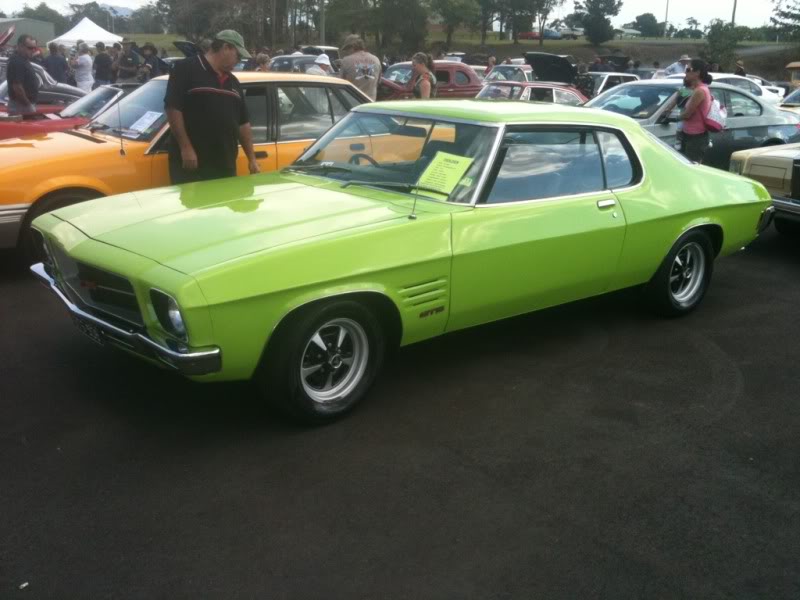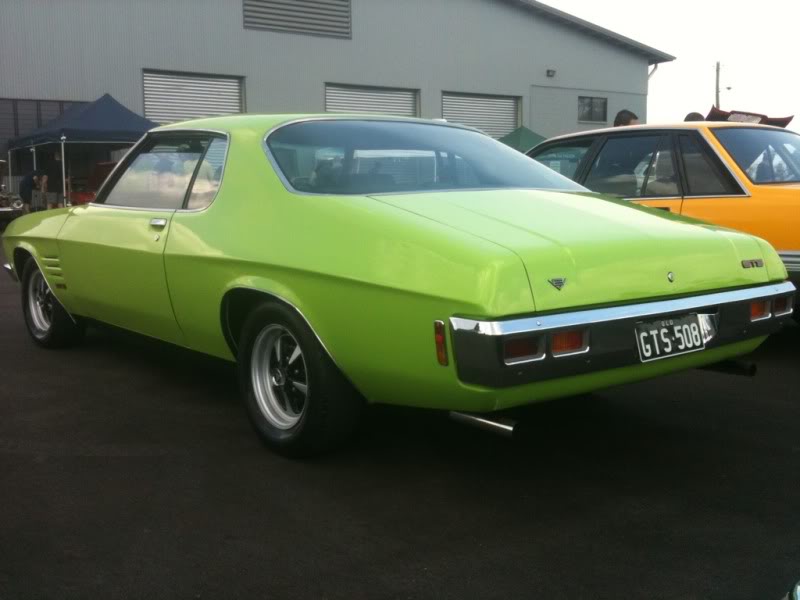I believe the ground cycles at for example 20hz, then the time that it is grounded for is varied. That way you could have it ground 20 times a second for very brief periods of time, adjustable until you hit the next cycle?
My newer Monaro
#426
 _jabba_
_jabba_
Posted 01 September 2011 - 10:27 PM
I believe the ground cycles at for example 20hz, then the time that it is grounded for is varied. That way you could have it ground 20 times a second for very brief periods of time, adjustable until you hit the next cycle?
#427
 _jabba_
_jabba_
Posted 01 September 2011 - 10:30 PM
The average value of voltage (and current) fed to the load is controlled by turning the switch between supply and load on and off at a fast pace. The longer the switch is on compared to the off periods, the higher the power supplied to the load is.
The PWM switching frequency has to be much faster than what would affect the load, which is to say the device that uses the power. Typically switchings have to be done several times a minute in an electric stove, 120 Hz in a lamp dimmer, from few kilohertz (kHz) to tens of kHz for a motor drive and well into the tens or hundreds of kHz in audio amplifiers and computer power supplies.
Sounds like what i said
#428

Posted 01 September 2011 - 10:36 PM
Yes but how does the MS vary the frequency? Say you want from 20khz to 200khz Thats why i mentioned a variable resistor to vary the frequencyyay for wikipedia
The average value of voltage (and current) fed to the load is controlled by turning the switch between supply and load on and off at a fast pace. The longer the switch is on compared to the off periods, the higher the power supplied to the load is.
The PWM switching frequency has to be much faster than what would affect the load, which is to say the device that uses the power. Typically switchings have to be done several times a minute in an electric stove, 120 Hz in a lamp dimmer, from few kilohertz (kHz) to tens of kHz for a motor drive and well into the tens or hundreds of kHz in audio amplifiers and computer power supplies.
Sounds like what i said.
#429
 _jabba_
_jabba_
Posted 01 September 2011 - 10:39 PM
For (a very poor) example say its set at 5hz (it cycles on and off 5 times a second)
|---|---|---|---|would provide more current than
|-|-|-|-|
- = time spent grounded
| = switching to ground
Sorry, really really bad example?
So the frequency that it operates is only really important to how smooth it operates, its how long it holds the switch closed that varies the current flow... I could probably use one of the pwm outputs for the idle air control motors, since there just stepper motors. I think it does a 4 wire output for those, I'm guessing so it can change directions rather than me relying on something to return to a position when current is removed.
Edited by jabba, 01 September 2011 - 10:47 PM.
#430

Posted 01 September 2011 - 11:15 PM
Ok so it will be a set speed which will go forward and reverse, i confused myselfms doesn't vary the frequency, it vary's how long it holds the switch closed during each cycle.
For (a very poor) example say its set at 5hz (it cycles on and off 5 times a second)|---|---|---|---|would provide more current than|-|-|-|-|
- = time spent grounded
| = switching to ground
Sorry, really really bad example?
So the frequency that it operates is only really important to how smooth it operates, its how long it holds the switch closed that varies the current flow... I could probably use one of the pwm outputs for the idle air control motors, since there just stepper motors. I think it does a 4 wire output for those, I'm guessing so it can change directions rather than me relying on something to return to a position when current is removed.
#431

Posted 02 September 2011 - 07:14 AM
What jabba is saying is that it varies (or rather modulates) the pulse width...
#432
 _jabba_
_jabba_
Posted 02 September 2011 - 08:21 AM
#433

Posted 02 September 2011 - 08:25 AM
I have a mate building his own cnc setup. One of the things he has to do is include end stop switches to tell the machine that the stepper motors have reached the end of their travel. Do you have to do this with your possible setup?
That might mean you either have to set it up mechanically or an actuator/solenoid as you have said.
cheers
Glenn
#434
 _jabba_
_jabba_
Posted 02 September 2011 - 10:44 AM
I just thought of a possible problem with using stepper motors.
I have a mate building his own cnc setup. One of the things he has to do is include end stop switches to tell the machine that the stepper motors have reached the end of their travel. Do you have to do this with your possible setup?
That might mean you either have to set it up mechanically or an actuator/solenoid as you have said.
cheers
Glenn
Could you ask your mate what kind of stepper motor would be suitable for what im doing? I'm after a motor that will turn based on the pwm applied to it but will return to home when current is removed. That would be ideal if it exists!
#435

Posted 02 September 2011 - 10:51 AM
#436
 _jabba_
_jabba_
Posted 02 September 2011 - 11:08 AM
#437
 _jabba_
_jabba_
Posted 02 September 2011 - 12:19 PM
#438

Posted 02 September 2011 - 12:45 PM
That would work well.Maybe what I want is a servo motor not a stepper. I was just thinking about my toy helicopter and how it changes the pitch of the blades
Basically you need a stepper/controller to behave like a RC servo.
A potentiometer mechanically moved by the accelerator, the potentiometer moves clock and anti clock wise and the stepper follows. I had a set up exactly like that 10 years ago when I was "into it". I�m sure Jaycar has this setup.
But if you want to use what you have on hand that would be a goes start, I think you would have a "trim" setting which reduces or increases movement of the servos which will be needed I think.
#439

Posted 02 September 2011 - 12:46 PM



This is my good mates 71 GTS.

Edited by hanra, 02 September 2011 - 12:49 PM.
#440

Posted 02 September 2011 - 01:25 PM
http://www3.towerhob...p?&I=LXLWS8&P=0
So long as it hooks up with your computer, it might be the answer!!
cheers
Glenn
#441

Posted 02 September 2011 - 02:01 PM
I belueve you will need PWM signal either from your computer or a stand alone system/generator, but you will need to figure how to put that into the stepper controller.
You could use the tacho signal also i think, but for simplicity i think a stand alone system would be better, be it servo or Jaycar kit
Edited by Bart, 02 September 2011 - 02:08 PM.
#442

Posted 02 September 2011 - 02:10 PM
#443

Posted 02 September 2011 - 02:24 PM
servos are controlled with a PWM signal driven to their signal wire. A PWM signal has three parameters that characterizes it: The first is the amplitude (or peak to peak voltage) of the signal. You should use from 3 to 5 volts for your signal, according to it's specifications. The second is the frequency. In PWM, the frequency is usually fixed to a value. For analog servos the frequency is 30-50 Hz, and for digital servos it is 300 to 400 Hz.
This info is on this page http://pcbheaven.com...C_Servos_Works/, I hope it helps
cheers
Glenn
Edited by r2160, 02 September 2011 - 02:25 PM.
#444
 _jabba_
_jabba_
Posted 02 September 2011 - 05:30 PM
#445
 _jabba_
_jabba_
Posted 02 September 2011 - 07:14 PM
#446

Posted 02 September 2011 - 07:35 PM
Hang it off your engine crane lolhttp://www.robotmarketplace.com/products/0-PL1390.html
Overkill but wow, that would do it.
#447
 _jabba_
_jabba_
Posted 02 September 2011 - 07:38 PM
It looks like I'm on the right path tho, that type of servo has power ground and pwm signal wire and runs on 12v
#448
 _jabba_
_jabba_
Posted 02 September 2011 - 07:49 PM
I guess once i've build the rig then i can workout how much torque is required to move it. This one do 200 oz/in at 6V where as the other one i posted can do Stall torque at 6V 400 oz-in.
only 40$ vs 290$
Ohhh look at this one!
yeah!
Edited by jabba, 02 September 2011 - 07:58 PM.
#449
 _Ozzie Picker_
_Ozzie Picker_
Posted 02 September 2011 - 07:53 PM
havn,t looked in your thread,mainly because of the heading my newer monaro,me was finking it was a 2002 model or soming like that.
glad i took the plunge,you have done a great job,i know how much work you have done,as i,m doing a warrick yellow HK,that was as bad or maybe worse,and has taken me years,in my spare time to get where it is today.
love the colour,i,m a metalic blue man also,i have a hk monaro a similar colour,which i mixed up the colour 24 years ago as a young fella.
if your interested i can add some pics of my cars.
cheers craig.
#450
 _jabba_
_jabba_
Posted 02 September 2011 - 07:55 PM
Post some pics, i don't mind
0 user(s) are reading this topic
0 members, 0 guests, 0 anonymous users





 View Garage
View Garage







